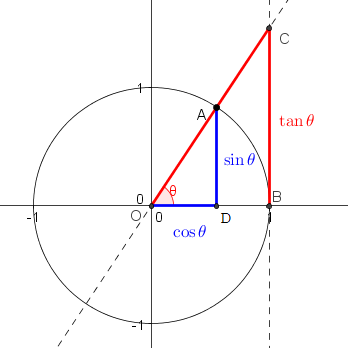Trigonometry+ 07
Problem A
Prove the following identity
2·arccos[√(1+x)/2] = arccos(x)
Proof A
By definition of function arccos(x), it's an angle in interval [0,π], whose cosine is x.
That is, cos(arccos(x))=x.
Therefore, we have to prove that cosine of the left side of an equality above equals to x.
Let's use a known identity
cos(2α)=2cos²(α)−1
Now
cos{2·arccos[√(1+x)/2]} =
= 2cos²{arccos[√(1+x)/2]}−1 =
= 2·[√(1+x)/2]² = x
Problem B
Simplify the expression
tan[½arctan(x)]
Hint B
Express tan(φ/2) in terms of tan(φ).
Solution B
Let angle φ = arctan(x).
We know that, by definition of function arctan(), its domain is all real values of x, its value, angle φ, is in the interval from −π/2 to π/2 and tan(φ)=x.
Hence, this problem can be formulated as
If a tangent of an angle φ is x, what is the tangent of the half of this angle?
Our first task is to express a tangent of the half of an angle in terms of a tangent of the whole angle.
As we know from UNIZOR.COM - Math 4 Teens - Trigonometry - Sum of Angles Problem 1 : tan(φ/2),
tan(φ)=2tan(φ/2)/[1−tan²(φ/2)]
Let's resolve this equation for tan(φ/2) in terms of tan(φ)
If A = 2B/(1−B²) then
A·B² + 2·B −A = 0
Solving this for B, we obtain
B1,2 = (−2±√4+4A²)/2A =
= (−1±√1+A²)/A
Using this for A=tan(φ) and B=tan(φ/2), we get the expression for tan(φ/2) in terms of tan(φ).
An important detail is that on interval (−π/2,π/2) the sign of tan(φ) and tan(φ/2) are the same (positive for positive angle and negative for negative angle).
Therefore, sign ± in the formula above should be replaced with + and the final formula expressing tan(φ/2) in terms of function tan(φ) is
tan(φ/2) =
= [−1+√1+tan²(φ)] /tan(φ)
Since φ=arctan(x) and tan(φ)=x, we can state the following:
tan[½arctan(x)] =
= [−1+√1+x²] /x
The value x=0 should be excluded from this formula, we can, obviously, say that in this case
tan[½arctan(x)] = 0
Problem C
Prove geometrically that for an acute angle θ, measured in radians, the following inequalities are true:
sin(θ) ≤ θ ≤ tan(θ)
Hint
Use the unit circle and a geometric interpretation of components of the inequality to be proven.
Proof

Since the radius of a circle is 1, the length of an arc AB is θ - a measure in radians of an angle ∠AOB.
By definitions of sin() and cos(), abscissa of point A (segment OD) equals to cos(θ) and the ordinate of point A (segment AD) equals to sin(θ).
Comparing the length of segment AD (that is, sin(θ)) and arc AB (that is, θ), taking into consideration that AD is a perpendicular to radius OB, while arc AB is a curve from the same original point A to OB, we conclude that the length of AD is less or equal to the length of arc AB with equality held only if point A coincides with point B, that is when angle θ is zero.
Therefore, we have proven that sin(θ) is less or equal to θ.
By definition of function tan(), it's a ratio of sin() to cos().
In our case it's a ratio of AD to OD.
Draw a perpendicular to OB at point B, and let C be an intersection of this perpendicular with a continuation of OA.
Since ΔOAD is similar to ΔOCB, the ratio of AD to OD is the same as the ratio of CB to OB. Since OB=1, tan(θ)=CB.
Area of circular sector AOB is less than area of right triangle COB.
Area of circular sector AOB of radius 1 equals to the area of a circle (that is, π) times θ/(2π), that is ½θ.
Area of a right triangle COB equals to ½CB·OB=½tan(θ).
Comparing these two areas, we conclude that θ is less or equal to tan(θ) with equality held only if point C coincides with point B, that is when angle θ is zero.


No comments:
Post a Comment